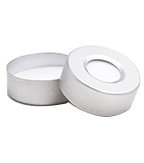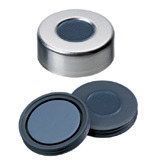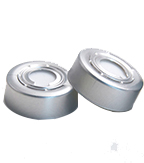Headspace vial volume refers to the volume of the vapor phase above the sample in a sealed vial. It is the total volume of the vial minus the volume occupied by the sample and any solid or liquid matrix.For example, if you have a 20 mL vial and add 5 mL of liquid sample, the headspace vial volume would be 15 mL. The headspace is the portion of the vial that contains the analytes of interest in the vapor phase.Headspace vial volume is an important parameter because it directly impacts the concentration of analytes in the vapor phase. The amount of analyte that partitions into the headspace depends on the sample matrix, temperature, and other factors. Optimizing the headspace vial volume can help maximize the concentration of analytes in the vapor phase for improved sensitivity and detection limits.
Headspace vial volume has several key effects on headspace gas chromatography analysis:
By optimizing the headspace vial volume, you can maximize the concentration of analytes in the vapor phase, improve sensitivity and precision, and ensure a linear response for quantitative analysis.
Several factors can influence the optimal headspace vial volume for HS-GC analysis:
By considering these factors, you can determine the ideal headspace vial volume for your specific HS-GC application and sample matrix.
To optimize headspace vial volume for HS-GC analysis, follow these best practices:
By following these best practices, you can optimize the headspace vial volume for your specific HS-GC application and ensure reliable, reproducible results.
Headspace vials manufactured by Aijiren are crafted from premium borosilicate glass, renowned for its exceptional durability, thermal stability, and chemical resistance. Available in sizes ranging from 6ml to 20ml, these vials cater to diverse sample volumes and analytical requirements. Moreover, Aijiren offers flexibility in closure options, with vials compatible with both 18mm screw caps and 20mm crimp caps. Whether opting for clear or amber vials, scientists can choose the ideal configuration to meet their specific needs. Aijiren’s screw thread headspace vials feature a 1.25 mm average wall thickness, offering enhanced reliability, particularly when internal pressures build during the analytical process. This robust design ensures the integrity of samples and minimizes the risk of leakage or contamination, even under demanding conditions. By adhering to or exceeding OEM standards, Aijiren guarantees the quality and performance of its headspace vials, providing scientists with confidence in their analytical results.
1. 18mm Screw Thread Headspace Vials ND18
.png) |
.png) |
.png) |
.png) |
|
| Part No. | VA101 | VA1035 | VA201 | VA2035 |
| Description | 10mL Clear Precision Screw Headspace Vial, Round Bottom, 22.5*46mm, 5.0 type |
10mL Amber Precision Screw Headspace Vial, Round Bottom, 22.5*46mm, 5.0 type |
20mL Clear Precision Screw Headspace Vial, Round Bottom, 22.5*75.5mm, 5.0 type |
20mL Amber Precision Screw Headspace Vial, Round Bottom, 22.5*75.5mm, 5.0 type |
2. 18mm Screw Thread Headspace Caps With Septa
 |
 |
 |
 |
 |
 |
 |
|
| Part No. | SACA001 | SACA002-II | SACA003-II | CA001 | SA001 | SA002-II | SA003-II |
| Description | Blue PTFE/White Silicone Septa, 13mm Black Screw Polypropylene Cap, 8.5mm Centre Hole |
Red PTFE/White Silicone Septa, 18mm Magnetic Precision Screw Metal Cap, 8mm Centre Hole |
White PTFE/Blue Transparent Silicone Septa, 18mm Magnetic Precision Screw Metal Cap, 8mm Centre Hole |
Magnetic Precision Screw Metal Cap, 8mm Centre Hole Φ18mm |
Blue PTFE/White Silicone Septa Φ 17.5*1.5mm |
Red PTFE/White Silicone Septa Φ 17.5*1.3mm Easy to puncture NEW TYPE |
White PTFE/Blue Transparent Silicone Septa Φ 17.5*1.3mm Easy to puncture NEW TYPE |
1. 20mm Headspace Crimp Vials ND20
 |
 |
 |
 |
|
| Part No. | VH0613 | VH1017 (Economy) VH1013 |
VHR1017 | VH1035 |
| Description | 6mL Clear Crimp-top Headspace Vial, Flat Bottom, 22*38mm |
10mL Clear Crimp-top Headspace Vial, Flat Bottom, 22.5*46mm |
10mL Clear Crimp-top Headspace Vial, Round Bottom 22.5*46mm |
10mL Amber Crimp-top Headspace Vial, Flat Bottom, 22.5*46mm |
 |
 |
 |
 |
|
| Part No. | VH2017 (Economy) VH2013 |
VHR2017 (Economy) VHR2013 |
VH2035 | VHR2035 |
| Description | 20mL Clear Crimp-top Headspace Vial, Flat Bottom, 22.5*75mm |
20mL Clear Crimp-top Headspace Vial, Round Bottom, 22.8*75mm |
20mL Amber Crimp-top Headspace Vial, Flat Bottom, 22.5*75mm |
20mL Amber Crimp-top Headspace Vial, Round Bottom, 22.5*75mm |
2. 20mm Crimp-top Aluminum Caps with Septa
 |
 |
.png) |
 |
 |
|
| Part No. | SC201201 | SBC201202 | MSC206201 | MSC207201 | SCS201201 |
| Description | White PTFE/White Silicone Septa, 20mm Crimp-top Aluminum Cap, 10mm Centre Hole |
White PTFE/White Silicone Septa, 20mm Crimp-top Blue Magnetic Aluminum Cap, 10mm Centre Hole |
Grey PTFE/Moulded Butyl Septa, 20mm Crimp-top Aluminum Cap, 10mm Centre Hole |
Grey PTFE/Pharma-Fix Butyl Septa, 20mm Crimp-top Aluminum Cap, 10mm Centre Hole |
White PTFE/White Silicone Septa |
To calculate the ideal headspace vial volume for HS-GC analysis, you can use the following equation:Headspace vial volume = (Total vial volume – Sample volume) / (1 + K × (Sample volume / Vial volume))Where:
The Henry’s law constant (K) represents the partitioning of the analyte between the liquid or solid sample and the vapor phase. It is dimensionless and can be calculated as:K = H × (Vial volume / (R × T × Sample volume))Where:
To determine the ideal headspace vial volume, you can rearrange the first equation to solve for the headspace vial volume:Headspace vial volume = (Total vial volume – Sample volume) / (1 + K)For example, let’s say you have a 20 mL headspace vial and you want to analyze benzene in a 5 mL liquid sample at 80°C. The Henry’s law constant for benzene at 80°C is 0.2236 atm·m³/mol.First, calculate the dimensionless Henry’s law constant (K):K = 0.2236 × (20 mL / (0.082057 L·atm/mol·K × (273.15 + 80) K × 5 mL))
K = 0.2236 × (20 / (0.082057 × 353.15 × 5))
K = 0.2236 × (20 / 72.5)
K = 0.2236 × 0.2759
K = 0.0617Then, calculate the ideal headspace vial volume:Headspace vial volume = (20 mL – 5 mL) / (1 + 0.0617)
Headspace vial volume = 15 mL / 1.0617
Headspace vial volume = 14.13 mLTherefore, the ideal headspace vial volume for this example would be approximately 14.13 mL.
Here are a few more examples of calculating the ideal headspace vial volume for HS-GC analysis:
Remember, these calculations provide a starting point for optimizing the headspace vial volume. You may need to adjust the volume based on factors such as sample matrix, analyte properties, and method validation results.
Headspace vial volume is a critical parameter in headspace gas chromatography analysis that can significantly impact the sensitivity, accuracy, and precision of your results. By understanding the factors that influence headspace vial volume and following best practices for optimization, you can ensure reliable, reproducible HS-GC analysis.